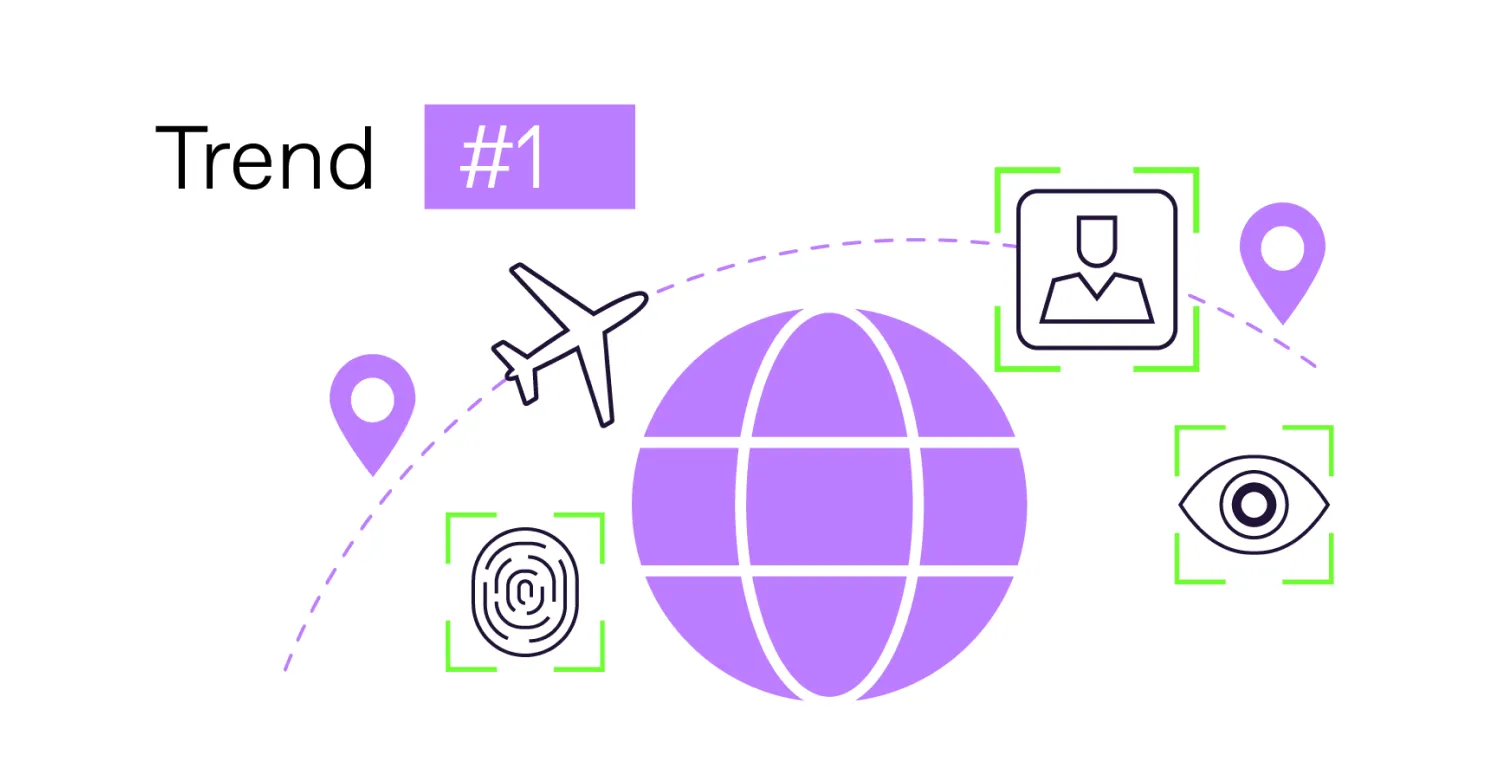Border crossings are undergoing a transformation. Biometrics are being rolled out at airports and even train stations, while new regulations, like the upcoming Schengen zone changes, are poised to reshape how travelers enter countries. Meanwhile, digital identity formats are gaining traction, adding complexity to traditional ID verification for travel.
As the travel industry navigates this transitional phase, travelers face a mix of manual passport checks and cutting-edge ID verification (IDV) technology such as self-check-in kiosks and walk-through gates.
This article explores the trends shaping the industry in the coming years, and how aviation and ground transport companies can create seamless travel experiences while reducing fraud in the travel industry and staying compliant with evolving regulations.
Trend #1. Biometrics at border crossings: A game changer?

Biometrics, particularly facial recognition, is rapidly becoming the new standard for travel identity verification. Airports and transport hubs are increasingly adopting this technology to streamline passenger flow, reduce wait times, and enhance security.
Where biometrics is already in use:
Airports: Major international airports in Europe, the US, Asia, etc., are rolling out biometric screening at security checkpoints, immigration, and boarding gates. Technologies like FACES by AirAsia, which allow passengers to board via facial recognition in under 30 seconds, exemplify how biometric systems can streamline operations while maintaining security.
Train stations: In Europe, biometric systems are also being integrated into train stations, particularly in countries with high-speed rail networks that connect to airports or border regions. For example, in the UK, Eurostar has introduced biometric checks using facial recognition for passengers boarding international trains at London St. Pancras International.
As biometrics become more widespread, they promise to transform the passenger experience by reducing queues and enhancing safety.
Get posts like this in your inbox with the bi-weekly Regula Blog Digest!
Trend #2. Schengen zone changes: How to adapt?

One of the biggest shifts in European border control is the upcoming implementation of the Entry/Exit System (EES) and the European Travel Information and Authorization System (ETIAS), slated to launch in November 2024. These changes will impact travelers entering the Schengen area, as well as transport companies managing cross-border travel.
The EES is designed to automate border control by replacing manual passport stamping. It will record the entry and exit of non-EU travelers to improve security and track overstays. Passengers will now be required to provide biometric data (facial and fingerprint) upon entry, streamlining subsequent border crossings.
ETIAS is a pre-travel authorization system for visa-free travelers entering the Schengen area. Starting in 2024, visitors from non-EU countries will need to apply online for ETIAS approval before traveling. This change will impact both airlines and train operators that facilitate cross-border travel, requiring them to verify that passengers have obtained ETIAS clearance before boarding.
Impact on transport companies
First and foremost, airlines and rail operators must adapt their check-in systems to comply with these new rules. Their software should be capable of verifying ETIAS approval and storing relevant biometric data where applicable. Failure to confirm that passengers have met Schengen entry requirements can result in penalties, increased wait times, and reputational damage.
Additionally, transport companies must pay special attention to staff training and education to ensure that every employee comprehends the new EES and ETIAS requirements. This will help to capture data (including biometrics) accurately and verify identities properly. Mismanagement at the check-in counter can result in passengers being denied boarding or turned away at the border, increasing delays and customer complaints.
Trend #3. The move toward digital identity documents: Wait for standards?

Digital ID formats are an emerging trend, with governments and companies worldwide experimenting with ways to replace traditional passports with digital alternatives. While the concept is still in its infancy, the potential for digital IDs to transform the travel experience is vast.
On the one hand, digital IDs offer passengers the convenience of carrying all travel documentation on their devices, simplifying the check-in process and reducing the reliance on paper documents. When combined with biometric verification, digital IDs could make travel truly frictionless.
On the other hand, widespread adoption requires robust infrastructure, international cooperation, and standardization. Digital ID systems also face security concerns, as any breach could have far-reaching consequences for the affected individuals and systems.
Current experiments in digital IDs
EU Digital Identity: The EU has been leading efforts to create a European Digital Identity, a secure digital wallet that would allow EU citizens to store and present ID information via their smartphones.
- US Digital Driver’s Licenses: Some US states are testing digital driver’s licenses, which could eventually become valid identification for both domestic flights and international travel.
The State of Digital IDs: A Commissioned Study Conducted by Forrester Consulting
Get a free copy
Trend #4. The unbalanced system: Between old and new IDV tech

As identity verification technologies evolve, the travel industry finds itself in a fragmented system. Traditional methods, such as manual passport checks, coexist with advanced IDV technologies like automated kiosks, facial recognition, and mobile-based ID verification. This creates inconsistencies in traveler experiences and can lead to bottlenecks in processing.
Current fragmentation:
Traditional paper checks: Many border control points and check-in counters still rely on outdated manual passport scanning systems.
Automated kiosks: Some airports and train stations have introduced self-check-in kiosks that allow passengers to scan their documents and board flights without human interaction.
E-gates:Biometric walk-through gates further speed up the process, allowing passengers to bypass traditional security lines altogether.
Transport operators and border agencies must collaborate to create consistent standards across regions and transport modes. Without uniformity, travelers will continue to encounter confusing and frustrating disparities in how their identities are verified.
Solutions for scaling IDV systems across passenger journeys
To ensure efficient identity verification at every stage of the passenger journey, companies need scalable travel and hospitality solutions. These systems should include the following features:

#1: Comprehensive end-to-end solutions
The future of IDV lies in end-to-end platforms that integrate multiple layers of identity verification, from document scanning to biometric authentication. By deploying comprehensive platforms, transport companies can centralize identity data, improving both security and the passenger experience. Plus, a system without dozens of moving parts is much easier to maintain.
#2: Automated document verification and authentication
Automated document verification uses advanced IDV technologies (including AI and machine learning) to verify the authenticity of travel documents in real time. This eliminates the need for manual inspection, reduces human error, and accelerates check-in processes. For transport companies, automating this step ensures compliance with regulations while minimizing wait times. As a result, this enhances the overall efficiency of border control and improves customer satisfaction.
#3: Face recognition + face matching capabilities
Integrating face recognition and face matching capabilities allows airlines and rail operators to seamlessly verify a passenger’s identity by comparing their live facial scan with the biometric data on file. This not only enhances security but also improves the speed of border crossings. For repeat travelers, it simplifies re-entry procedures by providing consistent, accurate identity verification with minimal passenger involvement.
#4: Secure data handling
With the rise in data breaches, secure handling of biometric and identity data is paramount. Transport companies must implement robust data protection protocols to safeguard sensitive passenger information. Secure data handling reduces the risk of cyberattacks and builds trust with customers. It also ensures compliance with data protection regulations like the GDPR while avoiding hefty fines and reputational damage.
#5: Comprehensive database of document templates
Having access to an up-to-date and comprehensive database of identity document templates allows IDV systems to quickly verify the authenticity of a wide range of international passports and travel documents. This ensures faster and more accurate identity verification for travelers from different countries, minimizes the risk of fraud, and reduces delays caused by unclear or inconsistent document recognition.
The road ahead
The future of identity verification for travel is filled with exciting developments. But as the travel industry transforms, so must the systems that verify passenger identities. Whether through biometrics, digital IDs, or AI-powered fraud detection, the future of ID verification promises faster, more secure, and more convenient travel for all.
To remain competitive, companies must invest in scalable IDV solutions and keep an eye on emerging technologies. Regula is here to support you along the way.





